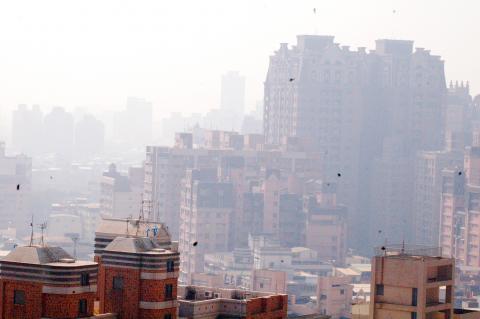The air pollution levels in all the nation’s cities and counties — except for Hualien and Taitung — failed to meet national standards for three consecutive years, thereby qualifying for the highest level in the Environmental Protection Administration’s (EPA) three-tier classification system for air-pollution-control zones.
The EPA yesterday released its monitoring data on PM2.5 — fine particulate matter measuring 25 micrometers in diameter or smaller — for the past three years, and only Hualien and Taitung had average PM2.5 levels lower than the EPA’s annual limit of 15 micrograms per cubic meter.
The national average PM2.5 concentration for the period was 23.1 micrograms per cubic meter, and Yunlin and Kinmen counties and Chiayi were the most polluted areas, with average PM2.5 concentrations of 33.3 micrograms per cubic meters, 31.5 micrograms and 32.7 micrograms respectively — more than double the EPA’s limit.

Photo: Huang Liang-chieh, Taipei Times
Under the EPA’s system, national parks and nature reserves are class-one air-pollution control zones; class-two zones are places where air quality meets national standards, while those areas where the air quality falls below standards for three years in a row are class-three zones.
The standards include indices of PM2.5, PM10, ozone, carbon dioxide, sulphur dioxide and nitrogen dioxide. Monitoring of PM2.5 levels began in 1997, but they were only included as an air quality index in 2012.
At present, only Kaohsiung and Pingtung are designated as a class-three zones due to their excessive PM10 and ozone levels.
This means that industries in the two locations are required to reduce emissions by 5 percent.
Taiwan Healthy Air Action Alliance founder Yeh Guang-peng (葉光芃) said that while the PM2.5 levels of many cities and counties were so high that it was clear by 2014 that these areas would quality as class-three zones by the end of last year, the EPA did not take steps to curb pollution.
The agency instead opted to allow pollution to continue at its current pace, Yeh said.
“Although three years of monitoring is the legal basis for designating control zones, the EPA should not be content to simply follow legal stipulations,” Yeh said.
“It should have taken proactive measures, designating these areas as class-three zones and implementing emergency measures to curb pollution,” Yeh said.
However, the EPA said the average PM2.5 and PM10 levels last year were 20 percent lower than those of 2008, and concentrations of traditional pollutants such as sulphur dioxide and nitrogen dioxide also dropped by more than 20 percent.
It has established more than 200 sets of regulations to control industrial and traffic emissions, the agency said.
It said it was also working to facilitate the replacement of outdated and energy-intensive facilities to lower the national PM2.5 level to 15 micrograms per cubic meter by 2020.

The combined effect of the monsoon, the outer rim of Typhoon Fengshen and a low-pressure system is expected to bring significant rainfall this week to various parts of the nation, the Central Weather Administration (CWA) said. The heaviest rain is expected to occur today and tomorrow, with torrential rain expected in Keelung’s north coast, Yilan and the mountainous regions of Taipei and New Taipei City, the CWA said. Rivers could rise rapidly, and residents should stay away from riverbanks and avoid going to the mountains or engaging in water activities, it said. Scattered showers are expected today in central and

People can preregister to receive their NT$10,000 (US$325) cash distributed from the central government on Nov. 5 after President William Lai (賴清德) yesterday signed the Special Budget for Strengthening Economic, Social and National Security Resilience, the Executive Yuan told a news conference last night. The special budget, passed by the Legislative Yuan on Friday last week with a cash handout budget of NT$236 billion, was officially submitted to the Executive Yuan and the Presidential Office yesterday afternoon. People can register through the official Web site at https://10000.gov.tw to have the funds deposited into their bank accounts, withdraw the funds at automated teller

COOPERATION: Taiwan is aligning closely with US strategic objectives on various matters, including China’s rare earths restrictions, the Ministry of Foreign Affairs said Taiwan could deal with China’s tightened export controls on rare earth metals by turning to “urban mining,” a researcher said yesterday. Rare earth metals, which are used in semiconductors and other electronic components, could be recovered from industrial or electronic waste to reduce reliance on imports, National Cheng Kung University Department of Resources Engineering professor Lee Cheng-han (李政翰) said. Despite their name, rare earth elements are not actually rare — their abundance in the Earth’s crust is relatively high, but they are dispersed, making extraction and refining energy-intensive and environmentally damaging, he said, adding that many countries have opted to

PEACE AND STABILITY: Maintaining the cross-strait ‘status quo’ has long been the government’s position, the Ministry of Foreign Affairs said Taiwan is committed to maintaining the cross-strait “status quo” and seeks no escalation of tensions, the Ministry of Foreign Affairs (MOFA) said yesterday, rebutting a Time magazine opinion piece that described President William Lai (賴清德) as a “reckless leader.” The article, titled “The US Must Beware of Taiwan’s Reckless Leader,” was written by Lyle Goldstein, director of the Asia Program at the Washington-based Defense Priorities think tank. Goldstein wrote that Taiwan is “the world’s most dangerous flashpoint” amid ongoing conflicts in the Middle East and Russia’s invasion of Ukraine. He said that the situation in the Taiwan Strait has become less stable